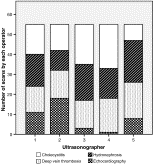Initial accuracy of bedside ultrasound performed by emergency physicians for multiple indications after a short training period
Correspondence
- Corresponding author. Hospital Infanta Cristina, Avenida Nueve De Junio 2, 28981 Parla, Madrid, Spain. Tel.: +34 65926587.

Correspondence
- Corresponding author. Hospital Infanta Cristina, Avenida Nueve De Junio 2, 28981 Parla, Madrid, Spain. Tel.: +34 65926587.
 Article Info
Article Info
To view the full text, please login as a subscribed user or purchase a subscription. Click here to view the full text on ScienceDirect.

Fig.
Number of explorations performed per physician.
Abstract
Purposes
Emergency physician–performed ultrasonography holds promise as a rapid and accurate method to diagnose multiple diseases in the emergency department (ED). Our objective was to assess the initial diagnostic accuracy (first 55 explorations) of emergency physician–performed ultrasonography for multiple categories of ultrasound use after a short training period.
Basic Procedures
This was a prospective observational study conducted at an urban ED from June 2010 to March 2011 in patients with suspected cholecystitis, hydronephrosis, deep vein thrombosis, and different cardiovascular problems. Five physicians had a 10-hour training session before enrolling patients. The test characteristics of bedside ultrasonography were determined with the final radiologist/cardiologist interpretation.
Main Findings
A total of 275 ultrasonographic examinations were performed (78 abdominal explorations, 80 renal explorations, 76 2-point compression ultrasonographic examinations in patients with suspected deep vein thrombosis, and 41 echocardiograms in patients with different acute cardiovascular problems). Radiologists/cardiologists detected 28 cases of cholecystitis, 26 cases of deep vein thrombosis, 49 cases of hydronephrosis, and 15 cases of significant cardiovascular alterations. The overall diagnostic accuracy of ED ultrasonograms yielded a sensitivity, specificity, positive predictive value, and negative predictive value of 92.6% (95% confidence interval [CI], 90%-99%), 89% (95% CI, 84%-94%), 86.2 % (95% CI, 82%-93%), and 94.2% (95% CI, 92%-99%), respectively. Nineteen (6.9%) false-positive results and 6 false-negative results (2.1%) were obtained.
Principal Conclusions
Emergency physicians in our institution attained reasonably high initial accuracy in the performance of ultrasonography for a variety of clinical problems after a 10-hour training period.
To access this article, please choose from the options below
Purchase access to this article
Claim Access
If you are a current subscriber with Society Membership or an Account Number, claim your access now.
Subscribe to this title
Purchase a subscription to gain access to this and all other articles in this journal.
Institutional Access
Visit ScienceDirect to see if you have access via your institution.
Related Articles
Searching for related articles..


